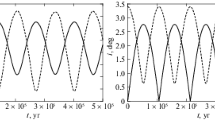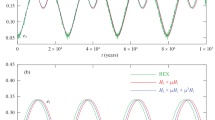Abstract
Two ways of defining the Poincaré astrocentric coordinates in the planetary problem are considered and compared. Both ways are shown to lead to the same system of equations of planetary motion after the elimination of the center of mass. Formulas for the transition from the osculating elements in the Poincaré coordinate system to the ordinary astrocentric osculating elements are given. The analytical apparatus constructed here is suitable for the practical application of perturbation methods, in particular, averaging methods.


Similar content being viewed by others
Notes
In contrast to the Poincaré coordinates, the Jacobi coordinates require expanding the perturbing potential of the system into a series in powers of planetary masses. However, as Charlier (1927) rightly pointed out, this shortcoming of the Jacobi coordinates is insignificant when constructing planetary theories.
The complementary part of the disturbing function appears in the theory of the second and higher orders in planetary masses.
REFERENCES
C. L. Charlier, Die Mechanik des Himmels (Walter de Gruyter, Berlin, 1927).
M. J. Duncan, H. F. Levison and M. H. Lee, Astron. J. 116, 2067 (1998).
N. V. Emel’yanov, Foundations of the Perturbation Theory in Celestial Mechanics, the Tutorial (Mosk. Gos. Univ., Moscow, 2015) [in Russian].
S. Ferraz-Mello, T. A. Micchtchenko, and C. Beaugé, in Chaotic Worlds: From Order to Disorder in Gravitational N-Body Dynamical Systems, Ed. by B. A. Steves, A. J. Maciejewski, and M. Hendry (Springer, New York, 2006), p. 255.
K. V. Kholshevnikov and V. B. Titov, The Two-Body Problem, the Tutorial (SPb Gos. Univ., St. Petersburg, 2007) [in Russian].
K. V. Kholshevnikov, A. V. Greb, and E. D. Kuznetsov, Solar System. Res. 35, 243 (2001).
G. A. Krasinskii, in Small Planets, Collection of Articles, Ed. by N. S. Samoilova-Yakhontova (Nauka, Moscow, 1973), p. 81 [in Russian].
J. Laskar and P. Robutel, Celest. Mech. Dyn. Astron. 62, 193 (1995).
A. P. Markeev, Theoretical Mechanics (Regulyar. Khaotich. Dinamika, Izhevsk, 2001) [in Russian].
A. V. Mel’nikov, V. V. Orlov, and I. I. Shevchenko, Astron. Rep. 58, 640 (2014).
D. V. Mikryukov, Astron. Lett. 42, 555 (2016).
D. V. Mikryukov, Astron. Lett. 44, 337 (2018).
D. V. Mikryukov, Astron. Lett. 46, 344 (2020).
D. V. Mikryukov and K. V. Kholshevnikov, Astron. Lett. 42, 268 (2016).
A. Morbidelli, Modern Celestial Mechanics: Aspects of Solar System Dynamics (Taylor Francis, London, 2002).
H. Poincaré, Leçons de Mécanique Céleste, tome I (Gauthier-Villars, Paris, 1905).
H. Rein, D. M. Hernandez, D. Tamayo, G. Brown, E. Eckels, E. Holmes, M. Lau, R. Leblanc, and A. Silburt, Mon. Not. R. Astron. Soc. 485, 5490 (2019).
P. Robutel, L. Niederman, and A. Pousse, Comput. Appl. Math. 35, 675 (2016).
A. Rodríguez and T. Gallardo, Astrophys. J. 628, 1006 (2005).
A. Wintner, The Analytical Foundations of Celestial Mechanics (Princeton Univ. Press, Princeton, 1941).
ACKNOWLEDGMENTS
I am grateful to K.V. Kholshevnikov (1939–2021) for the proposed theme. I also thank the anonymous referee for the useful remarks that contributed to an improvement of the paper.
Funding
This work was financially supported by the Russian Science Foundation (project no. 19-72-10023).
Author information
Authors and Affiliations
Corresponding author
Additional information
Translated by V. Astakhov
Rights and permissions
About this article
Cite this article
Mikryukov, D.V. On the Definition of the Astrocentric Coordinates in the Planetary Problem. Astron. Lett. 47, 782–789 (2021). https://doi.org/10.1134/S1063773721110049
Received:
Revised:
Accepted:
Published:
Issue Date:
DOI: https://doi.org/10.1134/S1063773721110049




